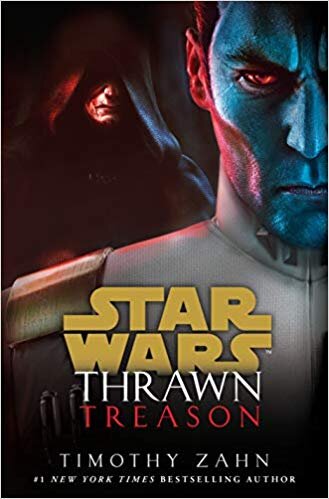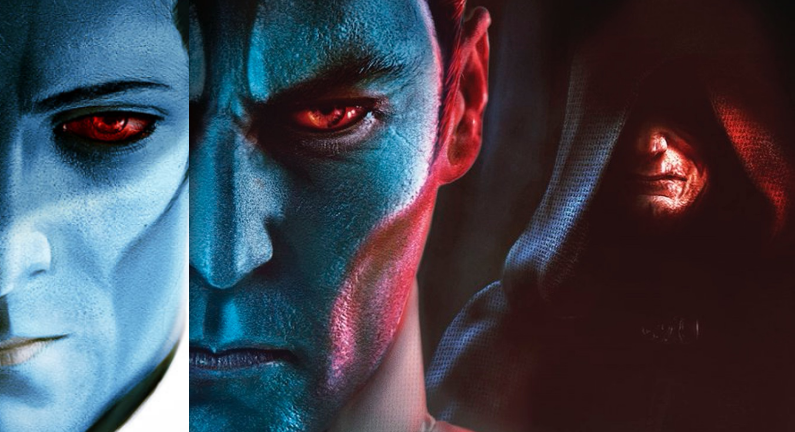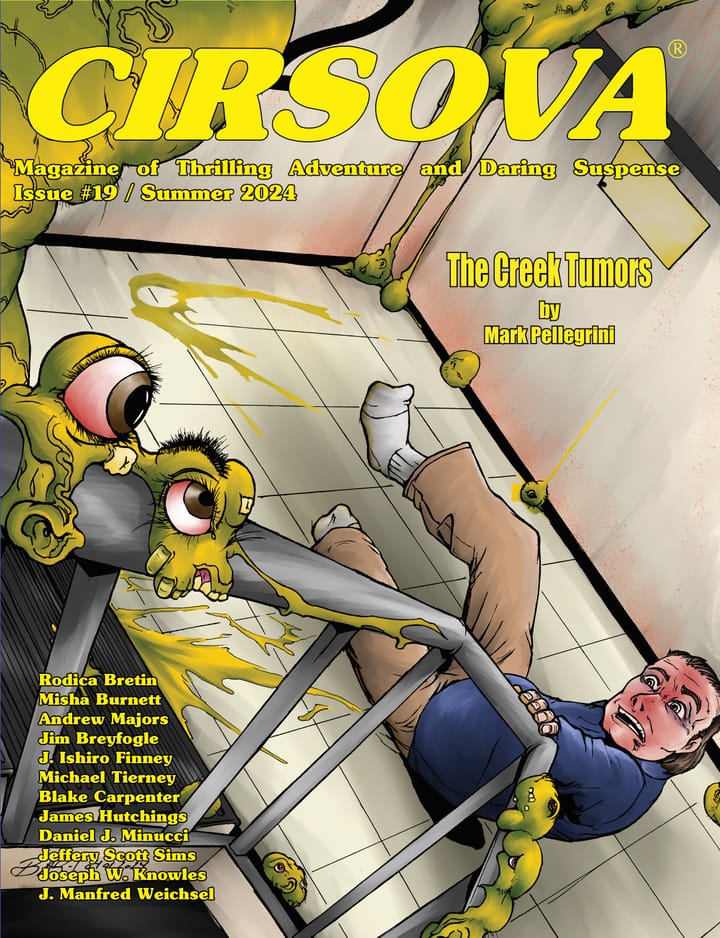Thrawn: Treason by Timothy Zahn Book Review
Thrawn: Treason [Amazon link] is very much the culmination of Timothy Zahn’s Grand Admiral Thrawn. And also, in a sense, the culmination of all his work. Here, we get to see the Grand Admiral at his best: elusive, brilliant, enigmatic. Victorious against all comers [perhaps]. If you want to know why the [perhaps], then indulge me.

Thrawn: Treason by Timothy Zahn Del Rey, 2019 $28.99; 352 pages ISBN 9781984820983
I kind of doubt that we will engage a serious number of readers at this point who aren’t Star Wars or Thrawn fans who know exactly what they are getting into, but let us briefly address the book in a way that meets the current standards for spoiler free reviewing. In Thrawn: Treason, the titular Grand Admiral engages with enemies within and without the Empire, using his unique ability to read the the intentions of others to navigate the tensions inherent in his position as the only non-human Grand Admiral as he investigates the disappearance of cargoes destined for Project Stardust.
If you don’t want the book spoiled, don’t read past this point.
What I would really like to do is engage with the book in a way that will illuminate its hidden depths, much like Thrawn himself continues to surprise even those who think they know him.
The Admiral Thrawn we meet in Thrawn: Treason reminds me very much of the unstoppable force that we met in Zahn’s original Heir to the Empire trilogy. Finally, in the third book of the trilogy set in the new Disney canon, we get to see again the machinations of an Imperial Commander who knows the enemy better than they know themselves. In the first volume of this new trilogy, we got to see some of this, but the scope of Thrawn’s brilliance was limited by the scope of Thrawn’s responsibilities. Now a Grand Admiral, in command of the Imperial Star Destroyer Chimaera, the master can set to work.
In the two years since Zahn re-launched his most popular character in the Star Wars universe, I have been working my way through Timothy Zahn’s extensive back catalogue. When I first read Thrawn, I was a little surprised that it took the form of a political thriller. In retrospect, I can now see that the intersection of Machiavellian politics, mystery, and science fiction is where Zahn works best. At the time I read Thrawn: Alliances, it struck me as somewhat experimental in style for Zahn. I still think that to be true. While Zahn has written books with as wide a sweep of years as are covered in Alliances, the parallel structure of the narrative, switching back and forth between the Clone Wars and Imperial eras was something I haven’t seen in Zahn’s works to date.
Now, in this final volume of Zahn’s Thrawn trilogy, everything is coming to fruition. In style, Treason is very much the best of what Zahn has done over his very long career. Subtle clues are seen from the point of view of characters like Eli Vanto and Commodore Faro, allowing perceptive readers to have the fun of seeing where Thrawn is going before he acts. And yet, the greatest conflicts that Thrawn faces are only implied, and also left unresolved.
In my review of Alliances, I suggested that Kathleen Kennedy’s decision to sweep away the entire Extended Universe was a blessing in disguise for Zahn. The previous version of Thrawn’s origin story, Outbound Flight [Amazon link],lacked sparkle. I suspect the reason is that there was simply too much that had changed with the prequels and fifteen years of Extended Universe for Thrawn’s original setup to work anymore, and Outbound Flight couldn’t quite bridge the gap.
However, at the same time, Treason feels like it could pretty exist comfortably within the old Extended Universe. I admit that I am fascinated by the way in which Zahn pretty clearly has his mind set in the old ways. For example, the opening paragraph of Treason:
The Imperial Star Destroyer floated lazily over the blue-green planet below it, a hint of those colors reflected faintly against its hull in the shadows created by the distant sun. The warship reached the end of its patrol sweep and, apparently satisfied that there was nothing amiss in the vicinity, angled away toward deep space. It continued its leisurely course until it reached the edge of the planet’s gravity well, then in a flurry of flashlines made the jump to lightspeed.
With both The Force Awakens and Rogue One featuring ships entering and exiting hyperspace quite close to planets, this idea of mass shadows preventing hyperspace travel that I think came from the old West End Games RPG sourcebooks doesn’t clearly make sense anymore. But here is Zahn, writing a whole trilogy that depends on the concept still working.
Ultimately, I find this to be a feature and not a bug. Arguments about canonicity and plot holes tend to be pointless, especially when I know good and well that everyone involved in any big fictional universe is just making stuff up as they go along. Zahn’s original Heir to the Empire novels were beloved long after the prequels made a hash of their backstory. And it doesn’t matter much now that these novels seem not to match two recent movies.
What is truly interesting is whether this might have been deliberate. Thrawn, like the Mandalorian, draws heavily on the Extended Universe for inspiration, and feels like it could easily exist in a fictional universe where the Disney sequels never happened. I suggested as much in my review of Alliances, and I don’t see anything here that changes that impression. The way this trilogy wraps up feels like Zahn has perfectly set up Thrawn to turn into the colder, harsher, more ruthless Grand Admiral we met in the Heir to the Empire books.
Now, for the ultimate of spoilers, I will look at the way the ending of Thrawn: Treason echoes the Last Command. In my review of the previous series, Zahn set Thrawn up in classical Greek style. The New Republic had no chance of defeating him on his terms, but he was undone by hubris, when his Noghri bodyguard drove a knife through his chest. Similarly, here Thrawn’s greatest opponent is not the venial and incompetent Grand Admirals and Moffs with which he routinely deals, nor the Grysk who encroach upon the Empire and the Chiss Ascendancy both, but the Emperor himself. In his hubris, Thrawn seeks to withhold his ultimate allegiance from a Sith.

The difference between Thrawn and Thrawn: Treason cover art
The cover art for the series deserves credit for recapitulating Thrawn’s character arc. The serene Thrawn of the first book has been replaced by a harsh one, with the Emperor looming in the background. Which perfectly represents the key conflict in this book, which despite its criticality takes place almost entirely off-stage. Outwardly, Thrawn is almost entirely victorious. In reality, he is in utmost peril.
The book ends on a rather dark note for Thrawn. Zahn leaves unsaid what happens in the final confrontation between the Grand Admiral and the Emperor, but it isn’t hard to imagine that even someone with as formidable a mind as Thrawn could be broken and corrupted by a Sith Lord as powerful as Sheev Palaptine, if Palpatine chose to put his full effort in. Thus, Zahn has created the perfect origin for a Thrawn very much like his previous incarnation, who calmly executed a conscript on his bridge who wasn’t giving his utmost effort.
The Thrawn we meet in this series of books has been absolutely fascinating. He chose to swear allegiance to the Emperor, dividing himself from his homeland and his heritage. He clearly does much good for the Empire, rooting out corruption, subtly promoting the competent and the honest from within. If a theme of the first book in this series was how the Empire came to be led by lickspittles and incompetents, a theme of this book is how there are nonetheless many virtuous and public-minded Imperials who seek to do good and serve within the system within which they find themselves.
Contra the Thrawn of Heir to the Empire, this Thrawn seeks to promote the good by protecting even his enemies within the Empire, giving opportunities for redemption and service for those who would otherwise be destroyed. The change is subtle. Thrawn is perfectly comfortable with enduring slavery, and hunting rebels against Imperial authority. Yet he clearly judges that order is superior to disorder, and that far greater threats exist than the Emperor and his rule. It is possible that Thrawn is mistaken in this judgment, but the evidence is at best ambiguous. Thrawn clearly has attempted to set up a kind of mental reservation, like Sir Thomas More, he is the Emperor’s good servant, but [blank’s] first.
To what, exactly, Thrawn owes his ultimate allegiance to is currently unclear. Zahn is committed to writing at least two more books, further back in time, so perhaps we shall find out. In the Star Wars universe, martyrdom is only available to Jedi, so I don’t know whether any kind of redemption is available for Thrawn. It certainly wasn’t for Goth Sullus. Nonetheless, I shall hope for him.
My other book reviews | Reading Log
Other books by Timothy Zahn
New Thrawn series:
Thrawn
Thrawn: Alliances
Quadrail series:
Night Train to Rigel: Quadrail book 1 review
The Third Lynx: Quadrail book 2 review
Odd Girl Out: Quadrail book 3 review
The Domino Pattern: Quadrail book 4 review
Judgement at Proteus: Quadrail book 5 review
Original Thrawn Trilogy:
Heir to the Empire
Dark Force Rising
The Last Command
Blackcollar series:
The Blackcollar: Blackcollar series book 1 review
The Backlash Mission: Blackcollar series book 2 review
Dragonback series:
Dragon and Thief
Dragon and Soldier
Dragon and Slave
Dragon and Herdsman
Dragon and Judge
Dragon and Liberator



Comments ()